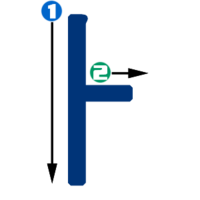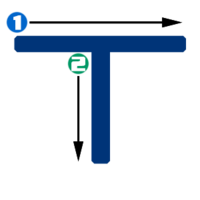Difference between revisions of "Hangeul step 2"
DigitalSoju (Talk | contribs) (→Did you jump to step 2?) |
DigitalSoju (Talk | contribs) |
||
| Line 1: | Line 1: | ||
| − | {{HangeulTop}} | + | {{HangeulTop/hr}} |
{| border=0 style="text-align:center; margin-left: auto; margin-right: auto;" | {| border=0 style="text-align:center; margin-left: auto; margin-right: auto;" | ||
| − | |- | + | |- |
| [[File:Back.png|link=Hangeul step 1|150px]] | | [[File:Back.png|link=Hangeul step 1|150px]] | ||
| [[File:Next.png|link=Hangeul step 3|150px]] | | [[File:Next.png|link=Hangeul step 3|150px]] | ||
| Line 38: | Line 38: | ||
!colspan="2"|Practice | !colspan="2"|Practice | ||
|- | |- | ||
| − | | 가 | + | | 가 |
| <flashmp3>ga H.mp3, ga M.mp3|leftbg=003478|rightbg=c60c30|lefticon=ffffff|righticon=ffffff|loop=yes</flashmp3> | | <flashmp3>ga H.mp3, ga M.mp3|leftbg=003478|rightbg=c60c30|lefticon=ffffff|righticon=ffffff|loop=yes</flashmp3> | ||
|} | |} | ||
| Line 62: | Line 62: | ||
!colspan="2"|Practice | !colspan="2"|Practice | ||
|- | |- | ||
| − | | 누 | + | | 누 |
| <flashmp3>nu H.mp3, nu M.mp3|leftbg=003478|rightbg=c60c30|lefticon=ffffff|righticon=ffffff|loop=yes</flashmp3> | | <flashmp3>nu H.mp3, nu M.mp3|leftbg=003478|rightbg=c60c30|lefticon=ffffff|righticon=ffffff|loop=yes</flashmp3> | ||
|- | |- | ||
| − | | 나 | + | | 나 |
| <flashmp3>na H.mp3, na M.mp3|leftbg=003478|rightbg=c60c30|lefticon=ffffff|righticon=ffffff|loop=yes</flashmp3> | | <flashmp3>na H.mp3, na M.mp3|leftbg=003478|rightbg=c60c30|lefticon=ffffff|righticon=ffffff|loop=yes</flashmp3> | ||
|- | |- | ||
| − | | 구 | + | | 구 |
| <flashmp3>gu H.mp3, gu M.mp3|leftbg=003478|rightbg=c60c30|lefticon=ffffff|righticon=ffffff|loop=yes</flashmp3> | | <flashmp3>gu H.mp3, gu M.mp3|leftbg=003478|rightbg=c60c30|lefticon=ffffff|righticon=ffffff|loop=yes</flashmp3> | ||
|} | |} | ||
| Line 92: | Line 92: | ||
!colspan="2"|Practice | !colspan="2"|Practice | ||
|- | |- | ||
| − | | 모 | + | | 모 |
| <flashmp3>mo H.mp3, mo M.mp3|leftbg=003478|rightbg=c60c30|lefticon=ffffff|righticon=ffffff|loop=yes</flashmp3> | | <flashmp3>mo H.mp3, mo M.mp3|leftbg=003478|rightbg=c60c30|lefticon=ffffff|righticon=ffffff|loop=yes</flashmp3> | ||
|- | |- | ||
| − | | 마 | + | | 마 |
| <flashmp3>ma H.mp3, ma M.mp3|leftbg=003478|rightbg=c60c30|lefticon=ffffff|righticon=ffffff|loop=yes</flashmp3> | | <flashmp3>ma H.mp3, ma M.mp3|leftbg=003478|rightbg=c60c30|lefticon=ffffff|righticon=ffffff|loop=yes</flashmp3> | ||
|- | |- | ||
| − | | 무 | + | | 무 |
| <flashmp3>mu H.mp3, mu M.mp3|leftbg=003478|rightbg=c60c30|lefticon=ffffff|righticon=ffffff|loop=yes</flashmp3> | | <flashmp3>mu H.mp3, mu M.mp3|leftbg=003478|rightbg=c60c30|lefticon=ffffff|righticon=ffffff|loop=yes</flashmp3> | ||
|- | |- | ||
| − | | 고 | + | | 고 |
| <flashmp3>go H.mp3, go M.mp3|leftbg=003478|rightbg=c60c30|lefticon=ffffff|righticon=ffffff|loop=yes</flashmp3> | | <flashmp3>go H.mp3, go M.mp3|leftbg=003478|rightbg=c60c30|lefticon=ffffff|righticon=ffffff|loop=yes</flashmp3> | ||
|- | |- | ||
| − | | 노 | + | | 노 |
| <flashmp3>no H.mp3, no M.mp3|leftbg=003478|rightbg=c60c30|lefticon=ffffff|righticon=ffffff|loop=yes</flashmp3> | | <flashmp3>no H.mp3, no M.mp3|leftbg=003478|rightbg=c60c30|lefticon=ffffff|righticon=ffffff|loop=yes</flashmp3> | ||
|} | |} | ||
| Line 127: | Line 127: | ||
!colspan="2"|Practice | !colspan="2"|Practice | ||
|- | |- | ||
| − | | 디 | + | | 디 |
| <flashmp3>di H.mp3, di M.mp3|leftbg=003478|rightbg=c60c30|lefticon=ffffff|righticon=ffffff|loop=yes</flashmp3> | | <flashmp3>di H.mp3, di M.mp3|leftbg=003478|rightbg=c60c30|lefticon=ffffff|righticon=ffffff|loop=yes</flashmp3> | ||
|- | |- | ||
| − | | 다 | + | | 다 |
| <flashmp3>da H.mp3, da M.mp3|leftbg=003478|rightbg=c60c30|lefticon=ffffff|righticon=ffffff|loop=yes</flashmp3> | | <flashmp3>da H.mp3, da M.mp3|leftbg=003478|rightbg=c60c30|lefticon=ffffff|righticon=ffffff|loop=yes</flashmp3> | ||
|- | |- | ||
| − | | 두 | + | | 두 |
| <flashmp3>du H.mp3, du M.mp3|leftbg=003478|rightbg=c60c30|lefticon=ffffff|righticon=ffffff|loop=yes</flashmp3> | | <flashmp3>du H.mp3, du M.mp3|leftbg=003478|rightbg=c60c30|lefticon=ffffff|righticon=ffffff|loop=yes</flashmp3> | ||
|- | |- | ||
| − | | 도 | + | | 도 |
| <flashmp3>do H.mp3, do M.mp3|leftbg=003478|rightbg=c60c30|lefticon=ffffff|righticon=ffffff|loop=yes</flashmp3> | | <flashmp3>do H.mp3, do M.mp3|leftbg=003478|rightbg=c60c30|lefticon=ffffff|righticon=ffffff|loop=yes</flashmp3> | ||
|- | |- | ||
| − | | 기 | + | | 기 |
| <flashmp3>gi H.mp3, gi M.mp3|leftbg=003478|rightbg=c60c30|lefticon=ffffff|righticon=ffffff|loop=yes</flashmp3> | | <flashmp3>gi H.mp3, gi M.mp3|leftbg=003478|rightbg=c60c30|lefticon=ffffff|righticon=ffffff|loop=yes</flashmp3> | ||
|- | |- | ||
| − | | 니 | + | | 니 |
| <flashmp3>ni H.mp3, ni M.mp3|leftbg=003478|rightbg=c60c30|lefticon=ffffff|righticon=ffffff|loop=yes</flashmp3> | | <flashmp3>ni H.mp3, ni M.mp3|leftbg=003478|rightbg=c60c30|lefticon=ffffff|righticon=ffffff|loop=yes</flashmp3> | ||
|- | |- | ||
| − | | 미 | + | | 미 |
| <flashmp3>mi H.mp3, mi M.mp3|leftbg=003478|rightbg=c60c30|lefticon=ffffff|righticon=ffffff|loop=yes</flashmp3> | | <flashmp3>mi H.mp3, mi M.mp3|leftbg=003478|rightbg=c60c30|lefticon=ffffff|righticon=ffffff|loop=yes</flashmp3> | ||
|} | |} | ||
| Line 155: | Line 155: | ||
|Text = ㅇ represents no sound when found in the initial position of a syllable. Instead, it simply acts as a placeholder since <u>vowels cannot be written by themselves</u>. However, if ㅇ is in the final (bottom) position, it makes an "ng" sound, i.e. 'si'''ng'''' or 'wro'''ng'''' ([[IPA]]: ŋ ), but these final position sounds will not be discussed until [[Hangeul_step_5|step 5]] of this lesson. For now, think of it as a placeholder for a consonant when only a vowel sound must be written. For full information about this letter, see [[ㅇ]]. <!--Insert picture--> | |Text = ㅇ represents no sound when found in the initial position of a syllable. Instead, it simply acts as a placeholder since <u>vowels cannot be written by themselves</u>. However, if ㅇ is in the final (bottom) position, it makes an "ng" sound, i.e. 'si'''ng'''' or 'wro'''ng'''' ([[IPA]]: ŋ ), but these final position sounds will not be discussed until [[Hangeul_step_5|step 5]] of this lesson. For now, think of it as a placeholder for a consonant when only a vowel sound must be written. For full information about this letter, see [[ㅇ]]. <!--Insert picture--> | ||
|Bgcolor = {{Kred}} | |Bgcolor = {{Kred}} | ||
| − | |Audio description1 = | + | |Audio description1 = |
| − | |Audio1 = | + | |Audio1 = |
| − | |Audio description2 = | + | |Audio description2 = |
| − | |Audio2 = | + | |Audio2 = |
}} | }} | ||
| Line 165: | Line 165: | ||
!colspan="2"|Practice | !colspan="2"|Practice | ||
|- | |- | ||
| − | | 아 | + | | 아 |
| <flashmp3>a H.mp3, a M.mp3|leftbg=003478|rightbg=c60c30|lefticon=ffffff|righticon=ffffff|loop=yes</flashmp3> | | <flashmp3>a H.mp3, a M.mp3|leftbg=003478|rightbg=c60c30|lefticon=ffffff|righticon=ffffff|loop=yes</flashmp3> | ||
|- | |- | ||
| − | | 우 | + | | 우 |
| <flashmp3>u H.mp3, u M.mp3|leftbg=003478|rightbg=c60c30|lefticon=ffffff|righticon=ffffff|loop=yes</flashmp3> | | <flashmp3>u H.mp3, u M.mp3|leftbg=003478|rightbg=c60c30|lefticon=ffffff|righticon=ffffff|loop=yes</flashmp3> | ||
|- | |- | ||
| − | | 오 | + | | 오 |
| <flashmp3>o H.mp3, o M.mp3|leftbg=003478|rightbg=c60c30|lefticon=ffffff|righticon=ffffff|loop=yes</flashmp3> | | <flashmp3>o H.mp3, o M.mp3|leftbg=003478|rightbg=c60c30|lefticon=ffffff|righticon=ffffff|loop=yes</flashmp3> | ||
|- | |- | ||
| − | | 이 | + | | 이 |
| <flashmp3>i H.mp3, i M.mp3|leftbg=003478|rightbg=c60c30|lefticon=ffffff|righticon=ffffff|loop=yes</flashmp3> | | <flashmp3>i H.mp3, i M.mp3|leftbg=003478|rightbg=c60c30|lefticon=ffffff|righticon=ffffff|loop=yes</flashmp3> | ||
|- | |- | ||
| Line 187: | Line 187: | ||
| <flashmp3>gagu H.mp3, gagu M.mp3|leftbg=003478|rightbg=c60c30|lefticon=ffffff|righticon=ffffff|loop=yes</flashmp3> | | <flashmp3>gagu H.mp3, gagu M.mp3|leftbg=003478|rightbg=c60c30|lefticon=ffffff|righticon=ffffff|loop=yes</flashmp3> | ||
|- | |- | ||
| − | | 가나다 (Korean alphabet, i.e. abc) | + | | 가나다 (Korean alphabet, i.e. abc) |
| <flashmp3>ganada H.mp3, ganada M.mp3|leftbg=003478|rightbg=c60c30|lefticon=ffffff|righticon=ffffff|loop=yes</flashmp3> | | <flashmp3>ganada H.mp3, ganada M.mp3|leftbg=003478|rightbg=c60c30|lefticon=ffffff|righticon=ffffff|loop=yes</flashmp3> | ||
|- | |- | ||
| − | | 가다 (to go) | + | | 가다 (to go) |
| <flashmp3>gada H.mp3, gada M.mp3|leftbg=003478|rightbg=c60c30|lefticon=ffffff|righticon=ffffff|loop=yes</flashmp3> | | <flashmp3>gada H.mp3, gada M.mp3|leftbg=003478|rightbg=c60c30|lefticon=ffffff|righticon=ffffff|loop=yes</flashmp3> | ||
|- | |- | ||
| Line 196: | Line 196: | ||
| <flashmp3>gaduda H.mp3, gaduda M.mp3|leftbg=003478|rightbg=c60c30|lefticon=ffffff|righticon=ffffff|loop=yes</flashmp3> | | <flashmp3>gaduda H.mp3, gaduda M.mp3|leftbg=003478|rightbg=c60c30|lefticon=ffffff|righticon=ffffff|loop=yes</flashmp3> | ||
|- | |- | ||
| − | | 고구마 (sweet potato) | + | | 고구마 (sweet potato) |
| <flashmp3>goguma H.mp3, goguma M.mp3|leftbg=003478|rightbg=c60c30|lefticon=ffffff|righticon=ffffff|loop=yes</flashmp3> | | <flashmp3>goguma H.mp3, goguma M.mp3|leftbg=003478|rightbg=c60c30|lefticon=ffffff|righticon=ffffff|loop=yes</flashmp3> | ||
|- | |- | ||
| − | | 고기 (meat) | + | | 고기 (meat) |
| <flashmp3>gogi H.mp3, gogi M.mp3|leftbg=003478|rightbg=c60c30|lefticon=ffffff|righticon=ffffff|loop=yes</flashmp3> | | <flashmp3>gogi H.mp3, gogi M.mp3|leftbg=003478|rightbg=c60c30|lefticon=ffffff|righticon=ffffff|loop=yes</flashmp3> | ||
|- | |- | ||
| Line 211: | Line 211: | ||
| <flashmp3>gido H.mp3, gido M.mp3|leftbg=003478|rightbg=c60c30|lefticon=ffffff|righticon=ffffff|loop=yes</flashmp3> | | <flashmp3>gido H.mp3, gido M.mp3|leftbg=003478|rightbg=c60c30|lefticon=ffffff|righticon=ffffff|loop=yes</flashmp3> | ||
|- | |- | ||
| − | | 나가다 (go out) | + | | 나가다 (go out) |
| <flashmp3>nagada H.mp3, nagada M.mp3|leftbg=003478|rightbg=c60c30|lefticon=ffffff|righticon=ffffff|loop=yes</flashmp3> | | <flashmp3>nagada H.mp3, nagada M.mp3|leftbg=003478|rightbg=c60c30|lefticon=ffffff|righticon=ffffff|loop=yes</flashmp3> | ||
|- | |- | ||
| Line 220: | Line 220: | ||
| <flashmp3>Namu H.mp3, Namu M.mp3|leftbg=003478|rightbg=c60c30|lefticon=ffffff|righticon=ffffff|loop=yes</flashmp3> | | <flashmp3>Namu H.mp3, Namu M.mp3|leftbg=003478|rightbg=c60c30|lefticon=ffffff|righticon=ffffff|loop=yes</flashmp3> | ||
|- | |- | ||
| − | | 나오다 (to come out) | + | | 나오다 (to come out) |
| <flashmp3>Naoda H.mp3, Naoda M.mp3|leftbg=003478|rightbg=c60c30|lefticon=ffffff|righticon=ffffff|loop=yes</flashmp3> | | <flashmp3>Naoda H.mp3, Naoda M.mp3|leftbg=003478|rightbg=c60c30|lefticon=ffffff|righticon=ffffff|loop=yes</flashmp3> | ||
|- | |- | ||
| Line 226: | Line 226: | ||
| <flashmp3>nai H.mp3, nai M.mp3|leftbg=003478|rightbg=c60c30|lefticon=ffffff|righticon=ffffff|loop=yes</flashmp3> | | <flashmp3>nai H.mp3, nai M.mp3|leftbg=003478|rightbg=c60c30|lefticon=ffffff|righticon=ffffff|loop=yes</flashmp3> | ||
|- | |- | ||
| − | | 누가 (who) | + | | 누가 (who) |
| <flashmp3>nuga H.mp3, nuga M.mp3|leftbg=003478|rightbg=c60c30|lefticon=ffffff|righticon=ffffff|loop=yes</flashmp3> | | <flashmp3>nuga H.mp3, nuga M.mp3|leftbg=003478|rightbg=c60c30|lefticon=ffffff|righticon=ffffff|loop=yes</flashmp3> | ||
|- | |- | ||
| − | | 누구 (who) | + | | 누구 (who) |
| <flashmp3>nugu H.mp3, nugu M.mp3|leftbg=003478|rightbg=c60c30|lefticon=ffffff|righticon=ffffff|loop=yes</flashmp3> | | <flashmp3>nugu H.mp3, nugu M.mp3|leftbg=003478|rightbg=c60c30|lefticon=ffffff|righticon=ffffff|loop=yes</flashmp3> | ||
|- | |- | ||
| Line 244: | Line 244: | ||
| <flashmp3>dogu H.mp3, dogu M.mp3|leftbg=003478|rightbg=c60c30|lefticon=ffffff|righticon=ffffff|loop=yes</flashmp3> | | <flashmp3>dogu H.mp3, dogu M.mp3|leftbg=003478|rightbg=c60c30|lefticon=ffffff|righticon=ffffff|loop=yes</flashmp3> | ||
|- | |- | ||
| − | | 마다 (every) | + | | 마다 (every) |
| <flashmp3>mada H.mp3, mada M.mp3|leftbg=003478|rightbg=c60c30|lefticon=ffffff|righticon=ffffff|loop=yes</flashmp3> | | <flashmp3>mada H.mp3, mada M.mp3|leftbg=003478|rightbg=c60c30|lefticon=ffffff|righticon=ffffff|loop=yes</flashmp3> | ||
|- | |- | ||
| Line 259: | Line 259: | ||
| <flashmp3>amado H.mp3, amado M.mp3|leftbg=003478|rightbg=c60c30|lefticon=ffffff|righticon=ffffff|loop=yes</flashmp3> | | <flashmp3>amado H.mp3, amado M.mp3|leftbg=003478|rightbg=c60c30|lefticon=ffffff|righticon=ffffff|loop=yes</flashmp3> | ||
|- | |- | ||
| − | | 아우 (man's younger brother-but not used anymore) | + | | 아우 (man's younger brother-but not used anymore) |
| <flashmp3>au H.mp3, au M.mp3|leftbg=003478|rightbg=c60c30|lefticon=ffffff|righticon=ffffff|loop=yes</flashmp3> | | <flashmp3>au H.mp3, au M.mp3|leftbg=003478|rightbg=c60c30|lefticon=ffffff|righticon=ffffff|loop=yes</flashmp3> | ||
|- | |- | ||
| − | | 아이 (child) | + | | 아이 (child) |
| <flashmp3>ai H.mp3, ai M.mp3|leftbg=003478|rightbg=c60c30|lefticon=ffffff|righticon=ffffff|loop=yes</flashmp3> | | <flashmp3>ai H.mp3, ai M.mp3|leftbg=003478|rightbg=c60c30|lefticon=ffffff|righticon=ffffff|loop=yes</flashmp3> | ||
|- | |- | ||
| Line 282: | Line 282: | ||
{| border=0 style="text-align:center; margin-left: auto; margin-right: auto;" | {| border=0 style="text-align:center; margin-left: auto; margin-right: auto;" | ||
| − | |- | + | |- |
|[[File:ㄱ stroke order.png|200px]]<br>ㄱ is written like this when combined with a horizontal vowel like ㅗ or ㅜ. | |[[File:ㄱ stroke order.png|200px]]<br>ㄱ is written like this when combined with a horizontal vowel like ㅗ or ㅜ. | ||
|[[File:ㄱ stroke order2.png|200px]]<br>ㄱ is written like this when combined with a vertical vowel such as ㅏ or ㅣ. | |[[File:ㄱ stroke order2.png|200px]]<br>ㄱ is written like this when combined with a vertical vowel such as ㅏ or ㅣ. | ||
| Line 299: | Line 299: | ||
| | | | ||
|} | |} | ||
| − | + | ||
==Video== | ==Video== | ||
Watch this lesson on talktomeinkorean.com's youtube channel: | Watch this lesson on talktomeinkorean.com's youtube channel: | ||
| Line 305: | Line 305: | ||
{| border=0 style="text-align:center; margin-left: auto; margin-right: auto;" | {| border=0 style="text-align:center; margin-left: auto; margin-right: auto;" | ||
| − | |- | + | |- |
| [[File:Back.png|link=Hangeul step 1|150px]] | | [[File:Back.png|link=Hangeul step 1|150px]] | ||
| [[File:Next.png|link=Hangeul step 3|150px]] | | [[File:Next.png|link=Hangeul step 3|150px]] | ||
|} | |} | ||
Revision as of 15:35, 21 April 2011
|
|
| Help · Cheat Sheet · Community portal |

|

|
Contents
Did you jump to step 2?
Did you skip step 1 because you were eager to just start learning the alphabet? Don't do it! We recommend you you go back to step 1 and read the general information on Hangeul, there are some important details that will help you from being confused later.
Introduction
We will introduce a consonant and vowel in pairs since consonants cannot be pronounced without the help of a vowel. Steps 2 through 4 are all either a consonant paired with a horizontal vowel or a consonant paired with a vertical vowel.
In this lesson, you will learn:
Also note that some of these files are set to loop, so you must manually stop the files yourself.
Step 2
|
| ||||||||||
|
This is a horizontal vowel and written to the right of the consonant. For full information about this letter, see ㅏ.
|
This is pronounced like a mix between a G and a K at the beginning of a word. However, when found between vowels, the sound is voiced and makes a /g/ sound. For full information about this letter, see ㄱ. | ||||||||||
| Practice | |
|---|---|
| 가 | |
|
| ||||||||||
|
This sound makes an "ooh" sound, similar to 'moon' or 'blue' or the U sound in Spanish (i.e. usted in "usted"). This is a vertical vowel and written below the consonant. For full information about this letter, see ㅜ.
|
This sound is the same as the N sound in English. For full information about this letter, see ㄴ. | ||||||||||
| Practice | |
|---|---|
| 누 | |
| 나 | |
| 구 | |
|
| ||||||||||
|
This is a vertical vowel and written below the consonant. For full information about this letter, see ㅗ.
|
This sound is the same as the M sound in English. For full information about this letter, see ㅁ. | ||||||||||
| Practice | |
|---|---|
| 모 | |
| 마 | |
| 무 | |
| 고 | |
| 노 | |
|
| ||||||||||
|
This sound is similar to the 'ee' sound in 'see' or 'free.' This is a horizontal vowel and written to the right of the consonant. For full information about this letter, see ㅣ.
|
This is pronounced like a mix between the sounds of a T and a D at the beginning of a word. However, when found between vowels, the sound is voiced and makes a /d/ sound. For full information about this letter, see ㄷ. | ||||||||||
| Practice | |
|---|---|
| 디 | |
| 다 | |
| 두 | |
| 도 | |
| 기 | |
| 니 | |
| 미 | |
| ||||
|
ㅇ represents no sound when found in the initial position of a syllable. Instead, it simply acts as a placeholder since vowels cannot be written by themselves. However, if ㅇ is in the final (bottom) position, it makes an "ng" sound, i.e. 'sing' or 'wrong' (IPA: ŋ ), but these final position sounds will not be discussed until step 5 of this lesson. For now, think of it as a placeholder for a consonant when only a vowel sound must be written. For full information about this letter, see ㅇ. | ||||
| Practice | |
|---|---|
| 아 | |
| 우 | |
| 오 | |
| 이 | |
Real Examples
| Word | Audio |
|---|---|
| 가구 (furniture) | |
| 가나다 (Korean alphabet, i.e. abc) | |
| 가다 (to go) | |
| 가두다 (to lock in) | |
| 고구마 (sweet potato) | |
| 고기 (meat) | |
| 고모 (father's sister) | |
| 구두 (dress shoes) | |
| 기도 (prayer) | |
| 나가다 (go out) | |
| 나누다 (to divide) | |
| 나무 (tree) | |
| 나오다 (to come out) | |
| 나이 (age) | |
| 누가 (who) | |
| 누구 (who) | |
| 누나 (older sister) | |
| 다가가다 (approach to someone) | |
| 다니다 (to go to, work, school etc) | |
| 도구 (instrument,tool) | |
| 마다 (every) | |
| 마디 (joint, knot) | |
| 모기 (mosquito) | |
| 아기 (baby) | |
| 아마도 (maybe,perhaps) | |
| 아우 (man's younger brother-but not used anymore) | |
| 아이 (child) | |
| 오다 (to come) | |
| 오이 (cucumber) | |
| 이기다 (to win) | |
| 이모 (mother's sister) |
Writing
Characters are written in a certain stroke order. Korean letters are written left to right, top to bottom. Remember stroke order is important, so please practice.
Video
Watch this lesson on talktomeinkorean.com's youtube channel:

|

|



















